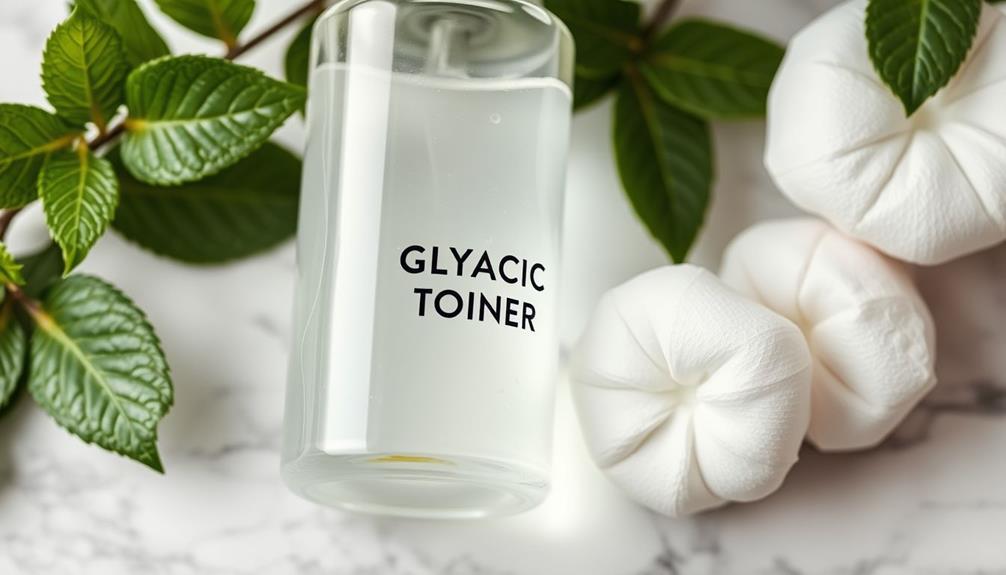Glycolic acid is the perfect solution for diminishing dark spots and achieving a more even skin tone. As a chemical exfoliant, it works by breaking down the bonds between dead skin cells, which helps speed up cellular turnover. This results in healthier skin and helps to reduce the appearance of dark patches by breaking down melanin deposits. Regular use not only improves skin texture and clarity but also boosts collagen production, enhancing skin firmness. To achieve optimal results, it’s important to learn the proper application techniques and tips from experts. Keep exploring to discover how to maximize the benefits of glycolic acid for your skin!
Key Takeaways
- Glycolic acid promotes exfoliation, effectively breaking down bonds between dead skin cells and accelerating the fading of dark spots.
- It dissolves melanin deposits, reducing the visibility of dark patches and enhancing overall skin clarity.
- Regular use helps treat post-inflammatory hyperpigmentation, making it beneficial for fading acne scars.
- By stimulating collagen production, glycolic acid improves skin texture and firmness, further aiding in the reduction of dark spots.
Glycolic Acid Explained

Glycolic acid, a powerful alpha hydroxy acid derived from sugar cane, penetrates your skin deeply to deliver effective exfoliation and rejuvenation.
As a chemical exfoliant, it works by dissolving the bonds between dead skin cells, enhancing cellular turnover. This process reveals healthier, more radiant skin, helping you achieve a smoother complexion.
Additionally, incorporating essential oils for skin health can complement the effects of glycolic acid by providing nourishment and antimicrobial properties.
One of the key benefits of glycolic acid is its ability to improve skin tone and reduce hyperpigmentation. By promoting the shedding of pigmented cells, it can help fade dark spots and create a more even skin surface.
Additionally, glycolic acid stimulates collagen production, which boosts skin firmness and elasticity, reducing the appearance of fine lines and wrinkles over time.
Regular use of glycolic acid can transform your skincare routine, giving you clearer skin and minimizing the visibility of age spots and post-acne marks.
Its exfoliating effects not only enhance the overall texture of your skin but also contribute to a brighter, more youthful appearance.
If you're looking for an effective solution to improve your skin tone and texture, glycolic acid is a powerful ally in your skincare arsenal.
Benefits for Dark Spots

Using glycolic acid in your skincare routine can greatly improve the appearance of dark spots and uneven skin tone. This powerful ingredient serves as a chemical exfoliant, promoting the exfoliation of dead skin cells and encouraging cell turnover. As a result, you can effectively fade dark spots and reduce hyperpigmentation over time.
Additionally, incorporating essential oils like Lavender or Tea Tree into your regimen can complement the benefits of glycolic acid by soothing the skin and enhancing the overall healing process. Glycolic acid works by breaking down melanin deposits in your skin, which helps diminish the visibility of those stubborn dark patches. Regular use can also aid in treating post-inflammatory hyperpigmentation, making it particularly beneficial for anyone dealing with dark spots from acne or other skin injuries.
Moreover, glycolic acid stimulates collagen production, which enhances your skin texture. This boost in collagen not only improves the overall appearance of your skin but also helps to diminish fine lines alongside dark spots.
Recommended Usage Guidelines

Start with a low concentration of glycolic acid (5-10%) and apply it once or twice a week to help your skin adjust. As your skin builds tolerance, you can gradually increase usage to three times per week.
To get the best results, follow these recommended usage guidelines:
- Use at Night: Apply glycolic acid in the evening to minimize sensitivity to UV rays and enhance absorption. Incorporating a calming bedtime routine can also help your skin recover overnight, much like how <a target="_blank" href="https://ourmindandbody.com">gentle yoga stretches</a> can prepare your body for rest.
- Cleanse First: Always cleanse your skin thoroughly before application to guarantee maximum penetration.
Since glycolic acid can heighten your skin's susceptibility to UV damage, don't forget to incorporate a broad-spectrum sunscreen with at least SPF 30 during the day.
Regular use over several weeks is crucial to effectively fade dark spots and improve your overall skin tone. Monitor how your skin responds based on your skin type, adjusting the frequency as needed.
Best Application Techniques
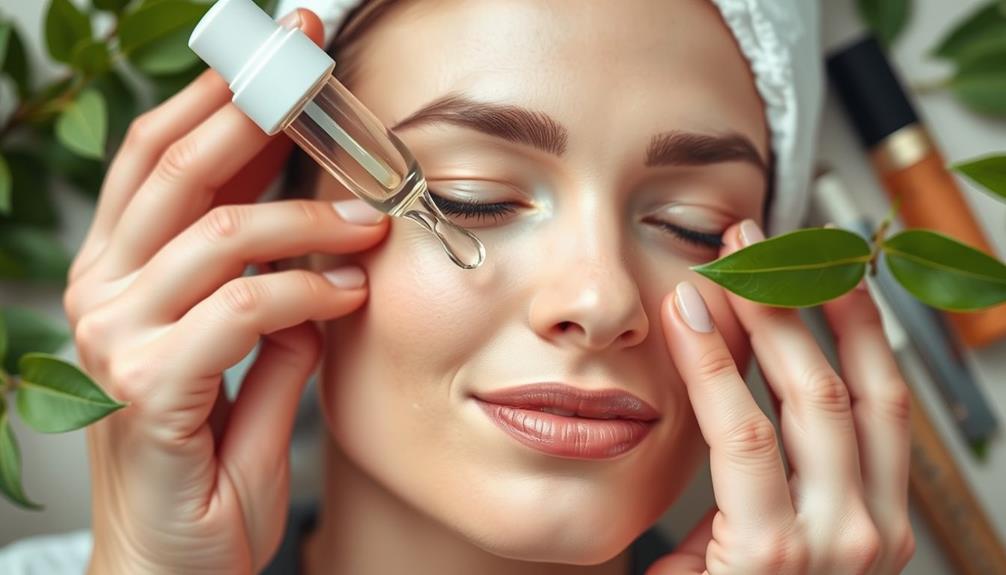
To get the most out of glycolic acid, apply it in the evening after cleansing and give your skin about 20-30 minutes to normalize its pH before treatment. This wait time enhances absorption and effectiveness, allowing glycolic acid to work its magic in fading dark spots.
Additionally, incorporating mindfulness practices, such as body awareness techniques, can promote overall emotional well-being during your skincare routine self-exploration through body awareness.
Start with a low concentration of glycolic acid, around 5-10%, and use it once a week. Gradually increase the frequency based on your skin tolerance to avoid irritation and excessive skin sensitivity.
After applying glycolic acid, follow up with a hydrating moisturizer. This step is fundamental as it helps mitigate dryness and irritation often associated with exfoliation.
Ingredient Compatibility
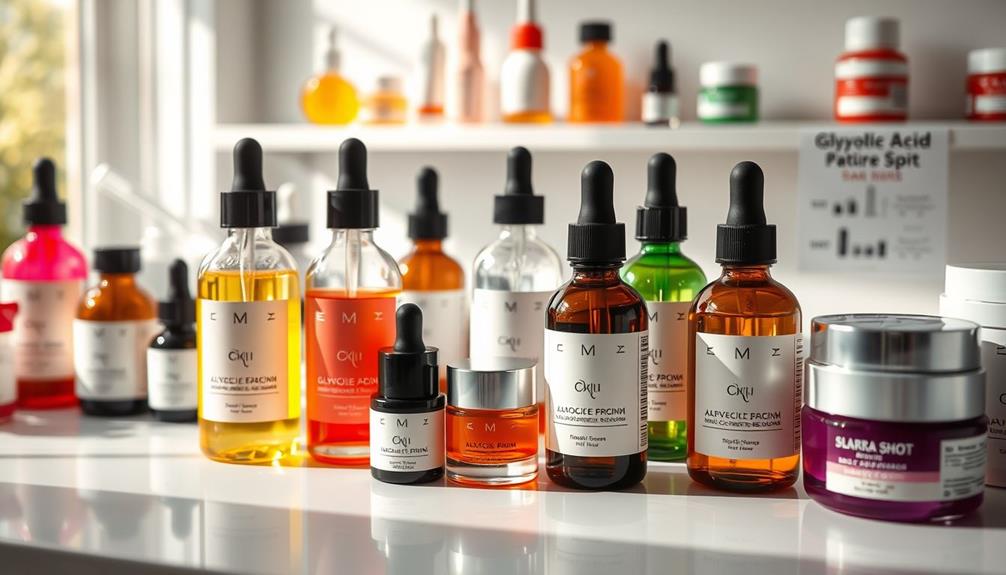
When using glycolic acid, it's essential to understand which ingredients work well together and which ones to avoid.
You'll want to pair it with hydrating agents like hyaluronic acid for added moisture, as well as consider the importance of ingredient sourcing, especially for vegan products.
While steering clear of combining it with Vitamin C to prevent irritation, knowing these compatibility tips can help you maximize the benefits of your skincare routine.
Ideal Ingredient Pairings
Glycolic acid pairs well with ingredients like hyaluronic acid and niacinamide, enhancing hydration and improving skin texture while addressing dark spots effectively. These combinations can help you achieve a brighter, more even complexion without sacrificing moisture or causing irritation. Incorporating a holistic lifestyle approach, including mindfulness in your skincare routine, can further enhance the benefits of these ingredients, leading to improved skin health and overall well-being stress management techniques.
Consider these ideal ingredient pairings for your skincare routine:
- Hyaluronic Acid: This ingredient hydrates your skin and counteracts any dryness from glycolic acid's exfoliating properties, keeping your skin plump and healthy.
- Niacinamide: When used together, glycolic acid and niacinamide can enhance skin texture and tone, though be mindful of potential pH incompatibility.
Using glycolic acid in your nighttime routine can yield the best results. You can also alternate it with retinol on different nights to maximize benefits while minimizing irritation.
Just remember, avoid mixing glycolic acid with ascorbic acid in the same application, as their differing pH levels can lead to irritation and reduce efficacy.
Avoiding Irritating Combinations
Avoiding irritating combinations is crucial for maintaining skin health, as certain ingredients can exacerbate sensitivity when paired with glycolic acid.
For instance, you should steer clear of using glycolic acid with ascorbic acid (Vitamin C) or retinoic acid, as these can cause irritation due to their conflicting pH levels. Layering glycolic acid with beta hydroxy acids like salicylic acid is also a no-go; doing so increases the risk of over-exfoliation and heightens skin sensitivity.
While niacinamide has its benefits, be cautious when combining it with glycolic acid, especially at low pH levels, to avoid potential irritation.
On the bright side, you can safely layer glycolic acid with hyaluronic acid. This combination enhances hydration by drawing moisture into the skin, helping to mitigate dryness caused by glycolic acid.
Before fully incorporating any new combinations into your routine, always perform a patch test. This helps you monitor for any adverse reactions and guarantees that your skin responds well, especially when introducing glycolic acid and other chemical exfoliants.
Your skin will thank you for being mindful of ingredient compatibility!
Managing Skin Sensitivity

Managing skin sensitivity is vital for successfully incorporating glycolic acid into your skincare routine without experiencing irritation or discomfort. To guarantee a smooth experience, follow these key steps:
- Perform a patch test: Always test a small area of skin before applying glycolic acid more widely. This helps you gauge your skin sensitivity and identify any adverse reactions.
- Use a hydrating serum: Applying a hydrating serum before glycolic acid can mitigate dryness and irritation. Look for serums rich in hyaluronic acid to keep your skin moisturized.
Starting with a lower concentration of glycolic acid (5-10%) is advisable, gradually increasing usage frequency as your skin adjusts.
Additionally, alternating glycolic acid with other active ingredients, like retinol, can minimize potential irritation. Using ceramide-based moisturizers can also support your skin barrier, guaranteeing a more comfortable experience while reaping the benefits of glycolic acid.
Long-term Effects on Skin
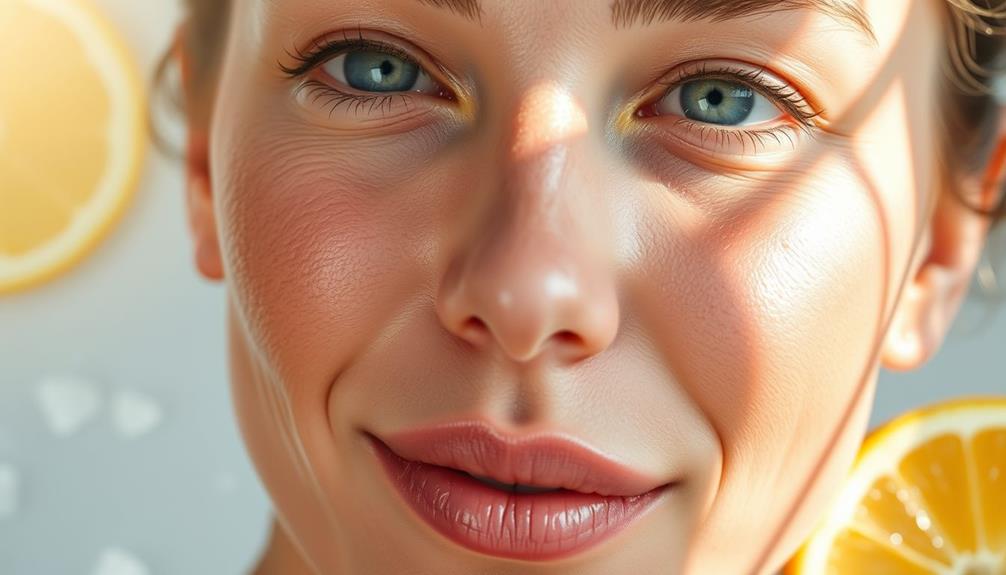
Using glycolic acid long-term can lead to noticeable improvements in your skin's texture and radiance.
You'll likely see a reduction in hyperpigmentation as it promotes cell turnover and enhances overall clarity.
Consistent use can transform your skin, giving it a healthier, more youthful appearance.
Enhanced Skin Texture
Glycolic acid greatly improves skin texture by promoting cellular turnover and revealing a smoother, more youthful complexion over time. By effectively exfoliating dead skin cells, it helps you achieve a brighter and more uniform complexion. The long-term benefits are significant, as regular use leads to enhanced skin firmness through increased collagen production.
Here are some key advantages of using glycolic acid for skin texture improvement:
- Smoother Surface: It removes rough patches, making your skin feel soft and revitalized.
- Increased Firmness: With boosted collagen production, your skin becomes more elastic, reducing the appearance of fine lines.
Incorporating glycolic acid into your skincare routine can transform your skin, making it look healthier and more refined. As you continue to use it, you'll notice a significant reduction in uneven texture and an overall improvement in skin quality.
Embrace the journey to achieving a more youthful and even complexion with glycolic acid, and enjoy the long-term benefits it offers for your skin.
Reduced Hyperpigmentation Visibility
Reduced visibility of hyperpigmentation becomes achievable through consistent exfoliation, revealing a more even skin tone as dead cells are shed and fresh skin emerges. Glycolic acid plays an essential role in this process.
By exfoliating the outer layer of skin, it promotes cell turnover, which helps lighten dark spots and reduces the appearance of age spots over time.
As you incorporate glycolic acid into your routine, you'll notice improvements not just in hyperpigmentation but also in overall skin texture. This acid enhances collagen production, leading to firmer skin that can better withstand the effects of time and sun exposure.
Regular use can even lighten post-inflammatory hyperpigmentation, making it particularly beneficial for those with acne scars.
For best results, consider using products with glycolic acid concentrations between 5% to 10%. You might also combine it with other skin-brightening agents for a more potent effect.
Over time, you'll likely see a noticeable reduction in the visibility of dark spots, giving your skin a clearer and more radiant appearance. Embracing this exfoliating powerhouse can truly transform your skincare journey.
Improved Skin Radiance
Achieving improved skin radiance becomes possible through the long-term benefits of glycolic acid, which promotes a brighter and more luminous complexion. By incorporating glycolic acid into your skincare regimen, you can experience significant changes in skin clarity and overall appearance.
Here are some key benefits:
- Enhanced Exfoliation: Glycolic acid increases cell turnover, shedding dead skin cells that dull your complexion.
- Collagen Production: It stimulates collagen production, leading to firmer skin and a smoother texture, which enhances radiance.
As you consistently apply glycolic acid, you'll notice your skin becoming brighter and more youthful. Clinical studies show it can lighten skin by one to two shades, contributing to a luminous appearance.
Over time, these effects culminate in improved skin radiance, allowing you to enjoy a vibrant complexion that reflects your inner health. With dedication to your skincare routine, glycolic acid can transform your skin, providing a lasting impact on its clarity and brightness.
Incorporating Into Daily Routine
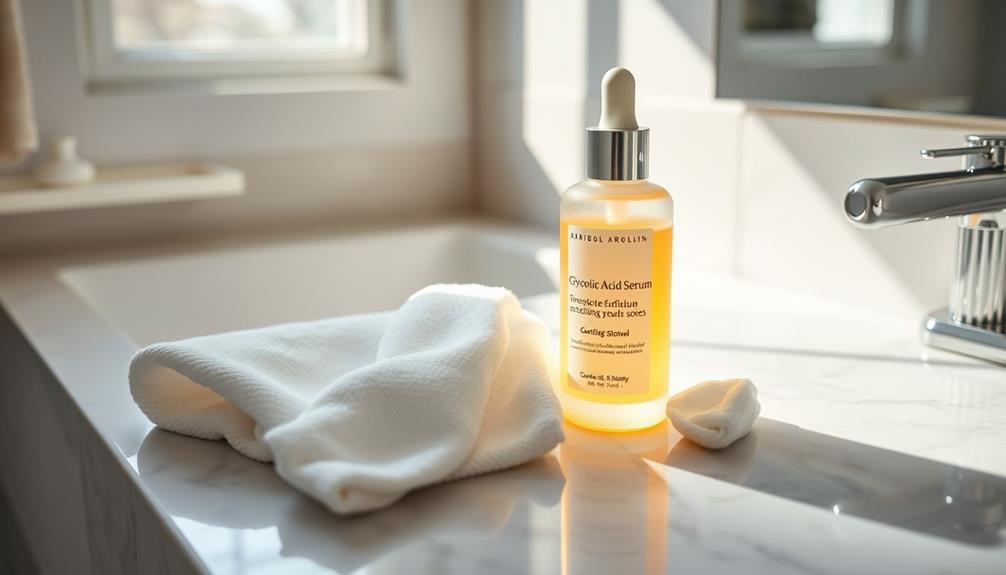
To effectively incorporate glycolic acid into your skincare routine, start with a low concentration of 5-10% and apply it once a week in the evening.
As your skin builds tolerance, gradually increase the frequency to two or three times per week.
Always cleanse your face thoroughly before application to enhance absorption, and follow up with a moisturizer to prevent dryness and irritation.
Since glycolic acid can increase sun sensitivity, it's vital to apply it at night and use a broad-spectrum sunscreen with SPF 30 or higher during the day.
Consistency is key in your regimen to achieve the best results in fading dark spots.
Many users notice improvements in skin tone and texture after several weeks to a few months of regular use.
Consider alternating glycolic acid with other active ingredients, like retinol, on different nights.
This strategy can help minimize irritation while maximizing the benefits of both products.
Expert Recommendations and Tips

Consulting with a dermatologist can provide personalized insights on how to effectively incorporate glycolic acid into your skincare routine for ideal results against dark spots. Here are some expert recommendations to get you started:
- Start Slowly: Begin with a lower concentration of glycolic acid (5-10%) to allow your skin to build tolerance. Gradually increase usage frequency as your skin adjusts.
- Combine Treatments: Use glycolic acid alongside other treatments like vitamin C or hydroquinone to enhance their effectiveness against hyperpigmentation.
Frequently Asked Questions
Does Glycolic Acid Remove Dark Spots Permanently?
Glycolic acid doesn't guarantee permanent removal of dark spots. While it helps fade them by exfoliating skin, underlying causes may remain. Consistent use alongside sun protection can enhance results over time, but don't expect miracles.
How Long Does It Take Glycolic Acid to Fade Dark Spots?
It usually takes about 4 to 6 weeks for glycolic acid to start fading dark spots, but you'll see ideal results in 8 to 12 weeks with consistent use tailored to your skin type.
Which Acid Is Best for Dark Spots?
Oh sure, pick the best acid for dark spots like you're choosing a favorite child! Glycolic acid's a superstar, but salicylic and lactic acids have their merits too. Experiment and find your skin's champion!
Does the Ordinary Glycolic Acid Toner Help With Dark Spots?
Yes, The Ordinary Glycolic Acid Toner can help with dark spots. By exfoliating and promoting cell turnover, it reveals fresher skin. Just remember to use sunscreen daily to protect against further pigmentation.
Conclusion
In the journey to radiant skin, glycolic acid acts like a guiding light, illuminating the path to fading dark spots.
By incorporating it into your routine, you're not just treating your skin; you're nurturing a fresh start.
Remember, each application is a step towards revealing your true beauty.
Embrace the process, listen to your skin, and soon, you'll see those stubborn marks fade, uncovering a canvas that's vibrant and renewed.
Let your skin shine!






